Playa Grande, Costa Rica-Hidden Gem for Beach Lovers
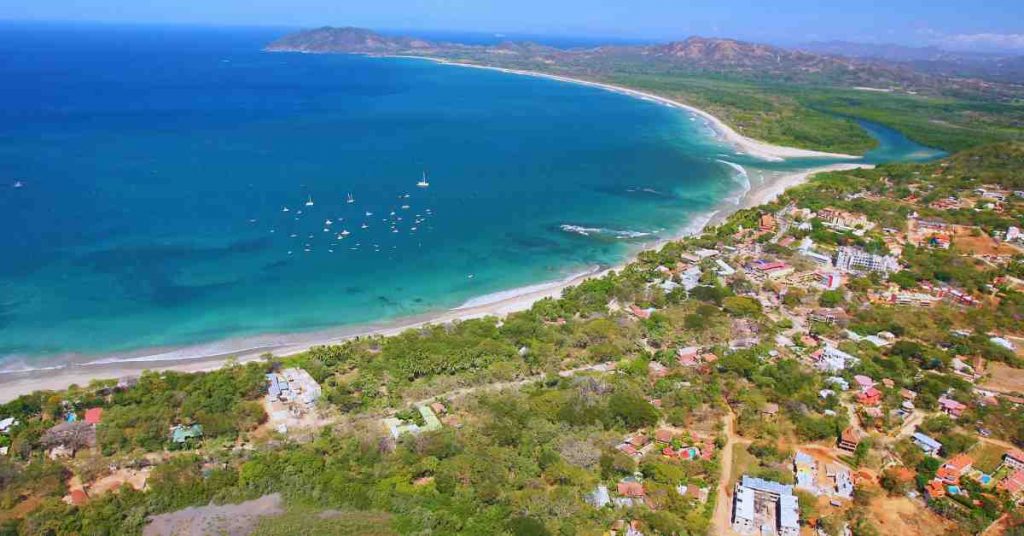
Experience Playa Grande, Costa Rica: A Hidden Gem for Beach Lovers and Wildlife Enthusiasts.
- Playa Grande, Costa Rica
- Geography and Location
- Natural Attractions
- Surfing Paradise
- Tourism and Activities
- Cultural Significance
- Visitor Information
- Features of Playa Grande, Costa Rica
- Facts About Playa Grande, Costa Rica
- Activities in Playa Grande, Costa Rica
- Foods that are popular in Playa Grande, Costa Rica
- What animals are in the Playa Grande?
- FAQs- Playa Grande, Costa Rica
- Q: How far is Playa Grande from Liberia International Airport?
- Q: What is the best time to visit Playa Grande?
- Q: What is Playa Grande known for?
- Q: Can I see leatherback turtles nesting in Playa Grande?
- Q: What activities can I enjoy in Playa Grande besides surfing?
- Q: Are there accommodations and restaurants in Playa Grande?
- Q: Is Playa Grande part of a protected area?
- Q: How can I reach Playa Grande from Liberia International Airport?
- Q: What wildlife can I expect to see in Playa Grande?
- Q: Is Playa Grande, Costa Rica worth visiting?
- Q: Can you swim at Playa Grande, Costa Rica?
- Q: What airport is in Playa Grande, Costa Rica?
- Q: How long is Playa Grande, Costa Rica?
- Q: Is Costa Rica an expensive destination?
- Q: What is Costa Rica famous for?
- Q: What ocean is Playa Grande, Costa Rica, located on?
- Q: How many rooms does Playa Grande have?
Playa Grande, Costa Rica
Playa Grande is a beautiful beach located on the Pacific coast of Costa Rica. It is situated in the Guanacaste province, near the town of Tamarindo. Playa Grande is known for its stunning natural beauty and pristine waters and is a popular destination for surfers.
There are palm trees and lush vegetation all around the beach, which has soft golden sand and stretches for about 4.5 kilometers (2.8 miles). It is part of the Las Baulas National Marine Park, which was established to protect the nesting grounds of endangered leatherback turtles. Playa Grande is one of the major nesting sites for these magnificent creatures, and visitors can witness the nesting and hatching process during the nesting season, which typically occurs from October to March.
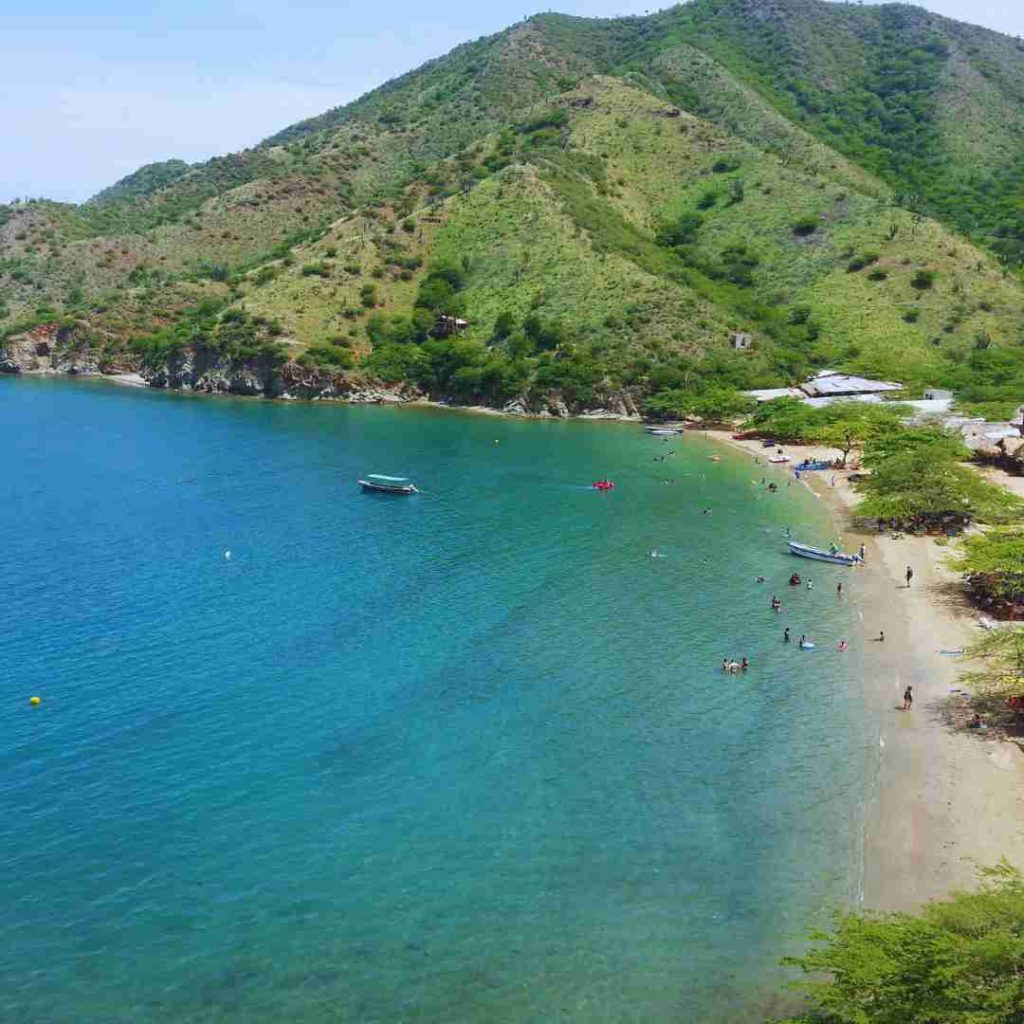
The main attraction of Playa Grande is its excellent surf breaks. The beach is renowned for its consistent waves, making it a favorite spot for surfers of all levels, from beginners to experienced riders. Surfing lessons and board rentals are available for those looking to learn or improve their skills.
While Playa Grande offers a more serene and laid-back atmosphere compared to the nearby bustling town of Tamarindo, it still provides amenities and services for visitors. Several hotels, vacation rentals, and beachfront restaurants along the beach offer a range of accommodations and dining options.
Playa Grande is an ideal destination for nature lovers, as diverse ecosystems surround it. Beyond the beach, you can explore the nearby mangrove forests, take boat tours along the estuaries, or venture into the neighboring national parks, such as Rincon de la Vieja or Santa Rosa, which offer hiking trails, wildlife spotting opportunities, and breathtaking landscapes.
Overall, Playa Grande, Costa Rica, is a captivating coastal destination that combines natural beauty, adventure, and relaxation, making it a popular choice for travelers seeking an authentic beach experience in Costa Rica.
This article overviews Playa Grande's geographical features, environmental significance, and notable attractions.
Geography and Location
Playa Grande is approximately 1 hour south of Liberia International Airport, making it easily accessible for visitors. The town lies within the Las Baulas National Marine Park, a protected area that safeguards important nesting grounds for endangered leatherback turtles.
Playa Grande is bordered by the Pacific Ocean to the west and is nestled between the towns of Tamarindo to the south and Playa Ventanas to the north.
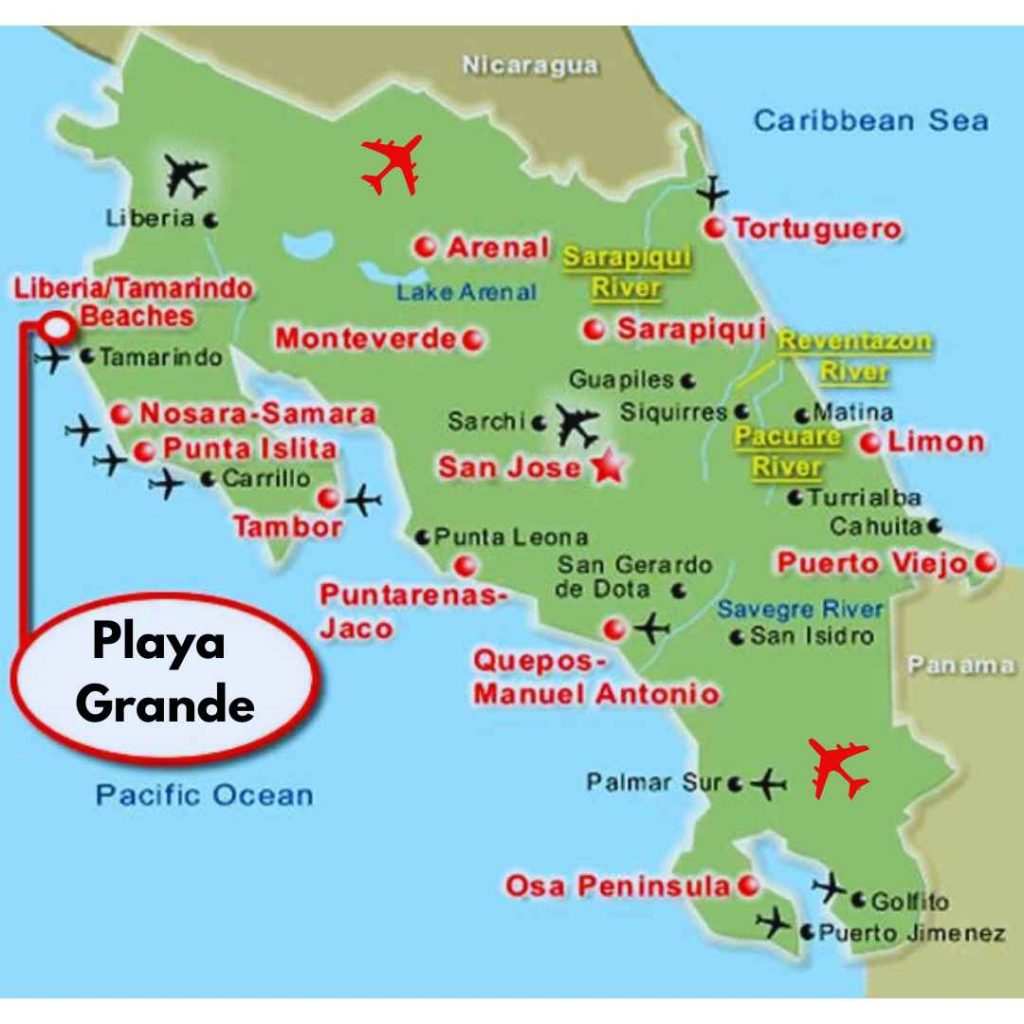
Natural Attractions
Playa Grande is renowned for its breathtaking natural beauty and diverse ecosystems. The beach stretches approximately 4.5 kilometers (2.8 miles)., offering pristine white sand and clear turquoise waters. Its unspoiled environment provides an idyllic setting for various activities such as swimming, sunbathing, and beachcombing.
One of the most significant natural attractions of Playa Grande is its role as a nesting site for endangered leatherback turtles (Dermochelys coriacea). These magnificent creatures, known for their large size and distinctive leather-like shell, return to the beach annually to lay their eggs. Playa Grande's wide sandy shore provides an ideal habitat for nesting, making it an important location for the survival of this species.
Conservation efforts are in place to protect the nesting grounds, and visitors can witness the nesting process through guided turtle tours. Lush mangrove forests and diverse ecosystems characterize the surrounding area of Playa Grande. These habitats support a wide array of wildlife, including howler monkeys, iguanas, colorful tropical birds, and various reptiles. Nature enthusiasts can explore the region through guided hikes, kayak tours along estuaries, and other eco-adventures.
Surfing Paradise
Playa Grande has gained international recognition as a premier surfing destination. Surfers worldwide flock to the town to experience its consistent waves and exceptional breaks suitable for all skill levels. Whether you're a beginner or an experienced surfer, Playa Grande offers an exciting surfing experience. The beach's unique geographical features contribute to forming world-class waves, attracting surfers who seek the thrill of riding these powerful swells.
Tourism and Activities
Playa Grande provides a range of activities and amenities for tourists. Besides surfing and wildlife observation, visitors can engage in snorkeling, scuba diving, sport fishing, and horseback riding along the beach. The town offers a variety of accommodations, including hotels, vacation rentals, and eco-lodges that blend harmoniously with the natural environment.
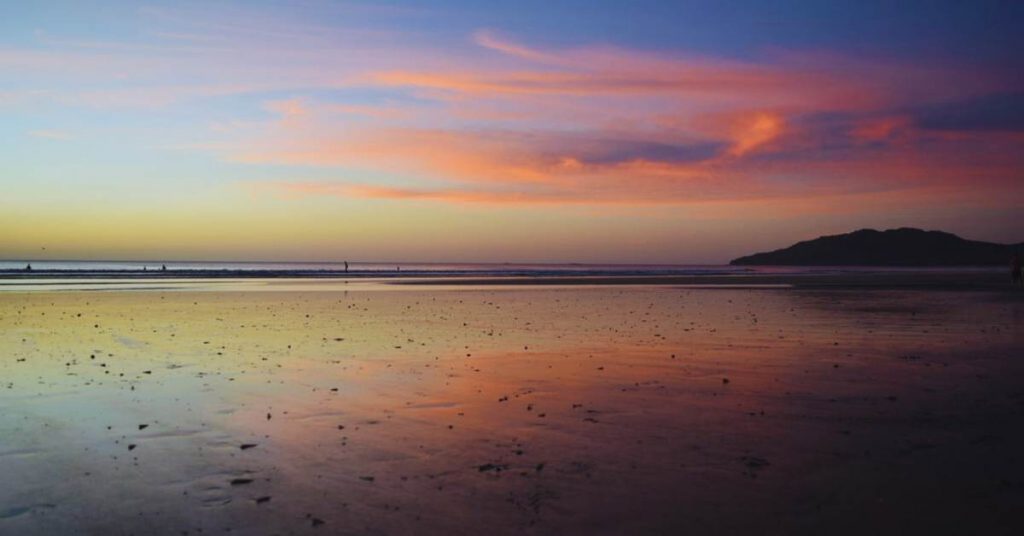
Cultural Significance
Playa Grande holds cultural significance for the local community and Costa Rica. It reflects the country's commitment to conservation and sustainable tourism practices. Efforts by the government and environmental organizations have focused on protecting Playa Grande's delicate ecosystems, particularly the nesting sites of leatherback turtles. These conservation initiatives demonstrate the community's dedication to preserving the area's natural heritage for future generations.
The local community plays an integral role in promoting responsible tourism and raising awareness about the importance of environmental conservation. They actively engage in educational programs, community outreach, and environmental initiatives aimed at preserving the pristine beauty and ecological balance of Playa Grande.
Visitor Information
Playa Grande welcomes visitors throughout the year, with the dry season (December to April) being the most popular time to visit. The town offers various services and amenities, including accommodations, restaurants, surf schools, and tour operators. It is advisable to book accommodations and tours in advance, especially during peak travel seasons.
Travelers can access Playa Grande via Liberia International Airport, which offers domestic and international flights. From the airport, various transportation options, such as private shuttles, taxis, and rental cars, can reach the town.
Features of Playa Grande, Costa Rica
Here's a table outlining some key features of Playa Grande, Costa Rica:
| Features | Description |
| Location | Located on the Pacific coast of Costa Rica |
| Beach | Playa Grande is a stunning sandy beach with golden sand |
| Surfing | Renowned as one of Costa Rica's premier surfing spots |
| Leatherback Turtles | Famous nesting site for endangered leatherback turtles |
| National Park | Adjacent to Las Baulas National Marine Park |
| Biodiversity | Rich in biodiversity with diverse plant and animal species |
| Nature Reserves | Surrounded by nature reserves and protected areas |
| Mangrove Estuary | Nearby estuary providing opportunities for eco-tourism |
| Birdwatching | Excellent spot for birdwatching with various bird species |
| Fishing | Fishing opportunities, including sportfishing |
| Tourism | Popular destination for tourists seeking natural beauty |
| Amenities | Offers various amenities like accommodations and restaurants |
| Accessibility | Accessible by road, approximately 1.5 hours from Liberia |
| Conservation | Conservation efforts to protect wildlife and ecosystems |
Facts About Playa Grande, Costa Rica
Here are some factual details about Playa Grande, Costa Rica:
Location:
Playa Grande is located in the Guanacaste province of Costa Rica on the Pacific coast. It is approximately 1 hour south of Liberia International Airport.
Las Baulas National Marine Park:
Playa Grande is part of the Las Baulas National Marine Park, established in 1990 to protect the nesting grounds of endangered leatherback turtles.
Leatherback Turtles:
Playa Grande is renowned as one of the most important nesting sites in the world for leatherback turtles (Dermochelys coriacea). These turtles can weigh up to 700 kilograms and return annually to lay their eggs on the beach from October to March.
Surfing Destination:
Playa Grande is widely recognized as a premier surfing destination in Costa Rica. It offers consistent waves and diverse breaks suitable for surfers of all skill levels. Longboarders particularly enjoy the waves at Playa Grande.
Biodiversity:
The surrounding area of Playa Grande is home to diverse flora and fauna. Visitors can spot howler monkeys, iguanas, colorful tropical birds, and various reptiles in the nearby mangrove forests and ecosystems.
Environmental Conservation:
Playa Grande is committed to environmental conservation and sustainable tourism practices. Efforts by the local community, government, and environmental organizations focus on preserving natural beauty and protecting the nesting sites of leatherback turtles.
Tourism and Activities:
Playa Grande offers a range of activities for tourists. Besides surfing, visitors can engage in snorkeling, scuba diving, sport fishing, horseback riding, and eco-tours. The town provides accommodations, restaurants, and other amenities to cater to visitors' needs.
Dry Season:
The dry season in Playa Grande runs from December to April, which is considered the peak travel period. The weather during this time is generally sunny and dry, perfect for beach activities and outdoor exploration.
Accessibility:
Playa Grande can be accessed via Liberia International Airport, which offers domestic and international flights. From the airport, travelers can choose various transportation options, such as private shuttles, taxis, or rental cars, to reach the town.
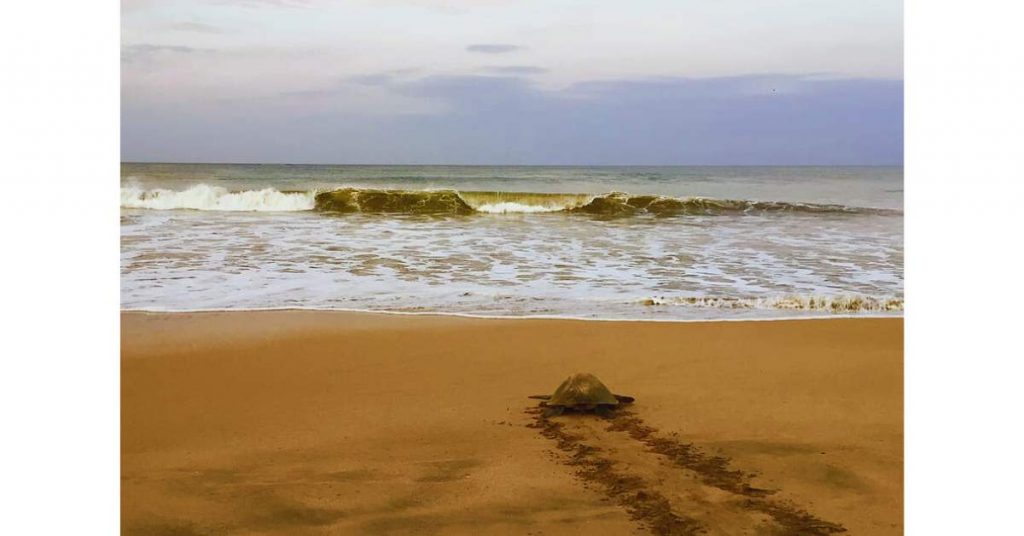
Activities in Playa Grande, Costa Rica
What activities can I do in Playa Grande, Costa Rica?
Playa Grande, Costa Rica, offers a range of exciting activities for visitors. Here are some popular activities you can enjoy:
Surfing:
Playa Grande is renowned for its exceptional surfing conditions. Whether a beginner or an experienced surfer, you can catch the waves and enjoy the thrill of riding the swells that roll in from the Pacific Ocean.
Wildlife Observation:
Explore the natural surroundings of Playa Grande and engage in wildlife observation. Take a guided tour to spot howler monkeys, iguanas, tropical birds, and various reptiles in the nearby mangrove forests and ecosystems.
Turtle Nesting Tours:
Playa Grande is an important nesting site for endangered leatherback turtles. Join a guided turtle nesting tour during the nesting season (usually from October to March) to witness these magnificent creatures as they come ashore to lay their eggs.
Snorkeling and Scuba Diving:
Explore the underwater world near Playa Grande through snorkeling or scuba diving. Discover vibrant coral reefs, tropical fish, and other marine life in the clear turquoise waters.
Sport Fishing:
Embark on a fishing excursion in the Pacific Ocean. Playa Grande offers opportunities for sport fishing, where you can try your luck at catching species such as marlin, sailfish, dorado, and more.
Horseback Riding:
Enjoy a horseback ride along the beach and through the picturesque surroundings of Playa Grande. It's a scenic and relaxing way to explore the area while experiencing the beauty of nature.
Kayaking and Stand-Up Paddleboarding:
Rent a kayak or try stand-up paddleboarding in the calm waters of nearby estuaries and mangrove forests. Glide through the serene surroundings and admire the diverse ecosystem.
Eco-Tours and Nature Walks:
Engage in eco-tours and guided nature walks to learn more about the region's flora, fauna, and ecological importance. Knowledgeable guides can provide insights into local biodiversity and conservation efforts.
Relaxation on the Beach:
Playa Grande offers pristine white sandy beaches where you can unwind, soak up the sun, and enjoy the tranquility of the surroundings. Take leisurely walks, build sandcastles, or indulge in a beach picnic.
These activities provide a glimpse into the natural wonders and adventure opportunities that Playa Grande has to offer. Check with local tour operators and adhere to responsible tourism practices to preserve this beautiful destination.
Foods that are popular in Playa Grande, Costa Rica
Playa Grande, Costa Rica, offers a variety of delicious and flavorful dishes that showcase the country's culinary traditions. Here are some popular foods you can enjoy in Playa Grande:
Gallo Pinto:
Considered the national dish of Costa Rica, Gallo Pinto is a hearty and flavorful combination of rice and black beans. It is often served for breakfast and accompanied by eggs, tortillas, and a side of sour cream.
Casado:
A traditional Costa Rican meal, Casado typically consists of rice, black beans, a choice of meat (such as grilled chicken, beef, or fish), plantains, salad, and often a small portion of corn tortillas. It offers a well-rounded and satisfying dining experience.
Ceviche:
As a coastal town, Playa Grande offers fresh and delicious ceviche. This dish typically features marinated seafood, such as shrimp or fish, in lime juice, mixed with onions, peppers, cilantro, and spices. It is a refreshing and tangy culinary delight.
Plantains:
Plantains are a staple in Costa Rican cuisine, and you'll find them in various forms. Tostones are fried green plantains served as a side dish or snack, while maduros are ripe plantains that are sweet and caramelized, often served as a dessert or accompaniment to savory dishes.
Chifrijo:
A popular bar snack, Chifrijo combines crispy fried pork, black beans, rice, and diced tomatoes. It is often topped with avocado and served with tortilla chips. The contrasting textures and flavors make it a delicious and satisfying choice.
Salsa Lizano:
Although not a dish itself, Salsa Lizano is a ubiquitous condiment in Costa Rica. This tangy and slightly sweet sauce is used to enhance the flavors of various dishes, from rice and beans to meats and salads.
Tres Leches Cake:
A beloved dessert in Costa Rica, Tres Leches Cake is a sponge cake soaked in three types of milk—evaporated milk, condensed milk, and heavy cream. It is moist, rich, and often topped with whipped cream and fruit.
Patacones:
Patacones are fried green plantain slices that are flattened and refried until crispy. They are commonly served as a side dish or as a base for toppings like beans, cheese, or meat, creating a delicious combination of textures and flavors.
Seafood:
Given its coastal location, Playa Grande offers a wide array of fresh seafood options. From grilled fish and shrimp to ceviche, seafood lovers can indulge in delicious dishes that highlight the flavors of the ocean.
Olla de Carne:
Olla de Carne is a traditional Costa Rican beef soup made with a variety of vegetables such as potatoes, carrots, plantains, corn, and yuca (cassava). It is a comforting and hearty dish often enjoyed for lunch or dinner.
Arroz con Mariscos:
This flavorful rice dish features a medley of mixed seafood, such as shrimp, fish, clams, and mussels, cooked with rice, vegetables, and spices. It is a delightful combination of textures and flavors.
Sopa Negra:
Sopa Negra, or "black soup," is a hearty black bean soup seasoned with garlic, onions, and cilantro. It is often served with a poached egg, white rice, and a drizzle of Lizano sauce, providing a comforting and satisfying meal.
Chicharrones:
Chicharrones are deep-fried pork rinds that are crispy and savory. They are commonly enjoyed as a snack or served with rice, beans, and plantains as part of a traditional Costa Rican meal.
Empanadas:
Empanadas are a popular snack or appetizer in Playa Grande. These delicious turnovers are typically filled with various ingredients such as cheese, beef, chicken, or vegetables and then fried or baked to perfection.
Fruit Smoothies:
Costa Rica is known for its abundance of tropical fruits. Enjoy refreshing fruit smoothies made with flavors like mango, pineapple, papaya, watermelon, and guava. They are a great way to cool down and taste the tropical flavors of the region.
These are just a few examples of the popular foods you can find in Playa Grande, Costa Rica. Exploring local restaurants, sodas (small eateries), and beachside cafes will provide you with a chance to savor the diverse and delectable cuisine the region has to offer.
What animals are in the Playa Grande?
Playa Grande, Costa Rica, is home to various fascinating animals on land and in the surrounding marine and coastal ecosystems.
Here are some notable animals you may encounter in and around Playa Grande:
Leatherback Turtles:
Playa Grande is famous for its nesting population of endangered leatherback turtles (Dermochelys coriacea). These magnificent creatures, known for their large size and distinctive ridged shells, return annually to the beach to lay their eggs.
Howler Monkeys:
Troops of howler monkeys inhabit Playa Grande. These charismatic primates are known for their loud calls and can often be spotted swinging through the trees or foraging for food in the nearby forests.
Iguanas:
Various species of iguanas, including the common green iguana, can be found in the Playa Grande area. These reptiles are often seen basking in the sun or climbing trees.
Birds:
Playa Grande boasts a diverse bird population. You may encounter colorful tropical birds such as scarlet macaws, toucans, parrots, and various species of herons and shorebirds. Watch for their vibrant plumage and listen for their melodic calls.
Reptiles:
Costa Rica is known for its reptile biodiversity, and Playa Grande is no exception. You might come across species such as green basilisks (also known as Jesus Christ lizards), black spiny-tailed iguanas, various snakes (including harmless species like boa constrictors and non-venomous snakes), and colorful anole lizards.
Marine Life:
Playa Grande is part of a thriving coastal ecosystem, providing opportunities to observe marine life. While snorkeling or scuba diving, you may encounter colorful fish, rays, sea turtles, eels, and even small sharks.
Butterflies and Insects:
The region is rich in insect life, including various butterflies, beetles, and other fascinating insects. The butterfly diversity is particularly remarkable, with species such as the blue morpho and various swallowtails adding splashes of color to the landscape.
Mammals:
In addition to howler monkeys, other mammal species can occasionally be spotted in the area. These may include white-faced capuchin monkeys, coatis, raccoons, and armadillos.
Remember that wildlife sightings are not guaranteed, as animals in their natural habitats can be elusive. However, Playa Grande's diverse ecosystems offer ample opportunities to observe and appreciate the region's unique fauna. Maintaining a respectful distance, avoiding disturbing the animals, and following responsible wildlife viewing practices are always important.
FAQs- Playa Grande, Costa Rica
Q: How far is Playa Grande from Liberia International Airport?
Ans: Playa Grande is approximately 1 hour south of Liberia International Airport by road.
Q: What is the best time to visit Playa Grande?
Ans: The dry season runs from December to April and is considered the best time to visit Playa Grande. During this period, the weather is typically sunny with minimal rainfall, making it ideal for outdoor activities.
Q: What is Playa Grande known for?
Ans: Playa Grande is renowned for several things, including its pristine beaches and exceptional surfing opportunities, and it is an important nesting site for endangered leatherback turtles.
Q: Can I see leatherback turtles nesting in Playa Grande?
Ans: Playa Grande is a crucial nesting ground for leatherback turtles. Guided turtle tours allow visitors to witness these magnificent creatures nesting on the beach, usually from October to March.
Q: What activities can I enjoy in Playa Grande besides surfing?
Ans: Besides surfing, Playa Grande offers various activities such as snorkeling, scuba diving, sport fishing, horseback riding, and eco-tours. The surrounding area also provides opportunities for wildlife observation and exploring the mangrove forests.
Q: Are there accommodations and restaurants in Playa Grande?
Ans: Yes, Playa Grande offers a range of accommodations, including hotels, vacation rentals, and eco-lodges. Several restaurants and dining options are also available to cater to visitors' needs.
Q: Is Playa Grande part of a protected area?
Ans: Yes, Playa Grande falls within the boundaries of the Las Baulas National Marine Park. The park was established to safeguard the nesting grounds of leatherback turtles and promote environmental conservation.
Q: How can I reach Playa Grande from Liberia International Airport?
Ans: Transportation options from the airport to Playa Grande include private shuttles, taxis, or rental cars. It is advisable to arrange transportation in advance to ensure a smooth journey.
Q: What wildlife can I expect to see in Playa Grande?
Ans: Playa Grande is home to wildlife, including howler monkeys, iguanas, colorful tropical birds, and diverse marine life. Exploring the mangrove forests and nearby ecosystems provides opportunities for wildlife observation.
Q: Is Playa Grande, Costa Rica worth visiting?
Ans: Yes, Playa Grande, Costa Rica, is definitely worth visiting. It offers stunning beaches, incredible surfing opportunities, abundant wildlife, and a relaxed coastal atmosphere. The town's proximity to the Las Baulas National Marine Park, renowned for its leatherback turtle nesting grounds, adds to its natural beauty and ecological significance.
Q: Can you swim at Playa Grande, Costa Rica?
Ans: Yes, swimming is possible at Playa Grande, Costa Rica. The beach features beautiful golden sand and clear waters, making it suitable for swimming. However, it's always important to observe the local conditions, including currents and signage, and exercise caution when swimming in any open-water environment.
Q: What airport is in Playa Grande, Costa Rica?
Ans: The nearest international airport to Playa Grande, Costa Rica, is Liberia International Airport (officially named Daniel Oduber Quirós International Airport). It is located in Liberia, Guanacaste, and serves as the main gateway for travelers visiting the region. From the airport, it takes approximately one hour to reach Playa Grande by road.
Q: How long is Playa Grande, Costa Rica?
Ans: Playa Grande Beach in Costa Rica stretches for approximately three miles along the coast. This expansive shoreline offers ample space for beachgoers to relax, enjoy the sun, and take in the stunning views of the Pacific Ocean. Whether strolling along the sandy shores, engaging in water activities, or simply unwinding on the beach, the three-mile stretch of Playa Grande provides plenty of room for leisure and exploration.
Q: Is Costa Rica an expensive destination?
Ans: Costa Rica can be considered a moderately expensive destination. Prices for accommodations, activities, and dining can vary depending on the location and level of luxury. While some aspects may be relatively affordable, certain tourist areas and high-end establishments can be more expensive. It is advisable to plan and budget accordingly.
Q: What is Costa Rica famous for?
Ans: Costa Rica is famous for its stunning natural beauty, including its lush rainforests, volcanoes, and diverse wildlife. It is also known for its commitment to environmental conservation, being one of the world leaders in sustainable tourism practices. Costa Rica's reputation as an adventure and eco-tourism destination, along with its warm and welcoming culture, contributes to its fame.
Q: What ocean is Playa Grande, Costa Rica, located on?
Ans: Playa Grande, Costa Rica, is located on the Pacific Ocean coast. It offers beautiful views of the Pacific and is renowned for its exceptional surfing conditions.
Q: How many rooms does Playa Grande have?
Ans: The number of rooms available in Playa Grande, Costa Rica, can vary depending on the accommodations offered in the area. Playa Grande features a range of options, including hotels, vacation rentals, eco-lodges, and bed and breakfasts. The number of rooms can differ from one establishment to another.
